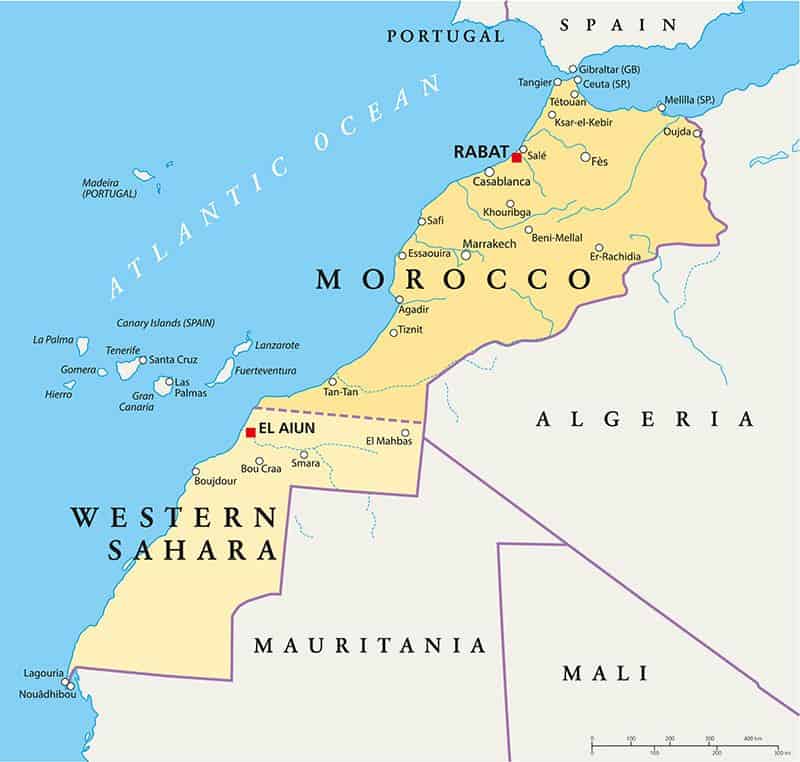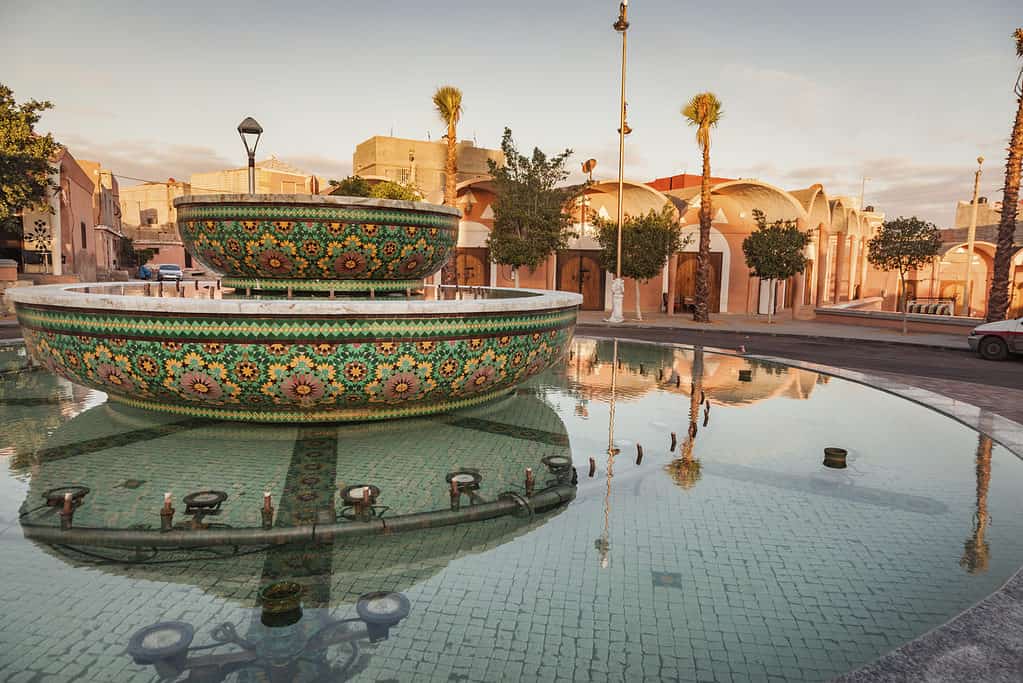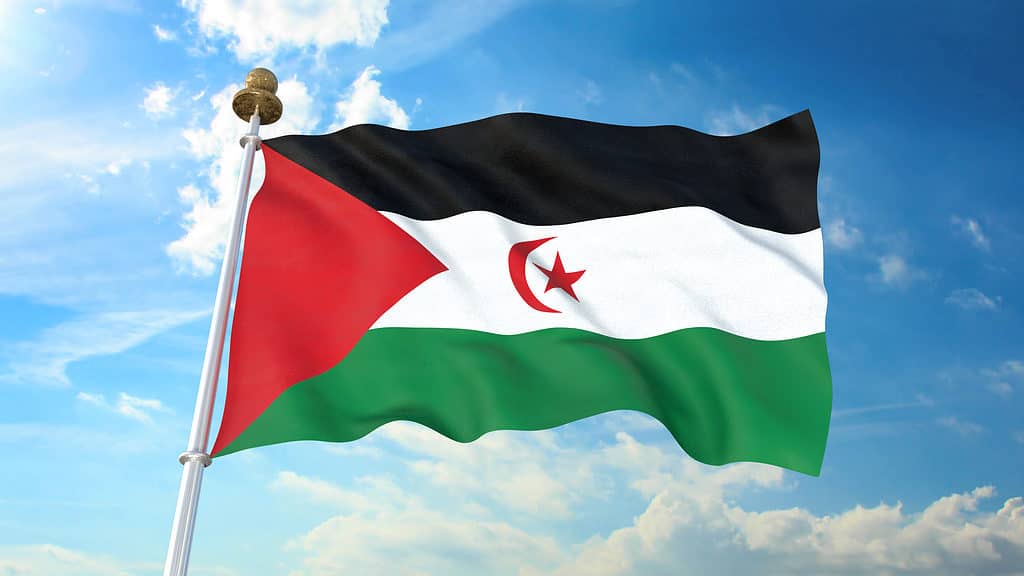Western Sahara, also known as the Sahrawi Arab Democratic Republic, is located on the northwest coast and is a disputed territory in North and West Africa’s Maghreb region. One of the many peculiarities of the nation is that the self-acclaimed Sahrawi Arab Democratic Republic (SADR) governs a small percentage of the country, while Morocco, with which it shares borders, governs at least 80% of the country. Since 1963, Western Sahara has been listed on the UN’s list of non-self-governing territories. It is the most populated and geographically largest territory on the list.
Because of its government history, Western Sahara is one of the most interesting countries to ever exist on the African continent. Read on to understand more about the country and its rich history, and how said history helped in choosing a flag. You will also discover the meaning and symbolism behind the country’s flag.

While the Sahrawi Arab Democratic Republic governs a small percentage of Western Sahara, Morocco governs at least 80% of the country.
©Peter Hermes Furian/Shutterstock.com
Characteristics of Western Sahara
Apart from being fascinating, Western Sahara is also one of the world’s most sparsely inhabited countries with a population of barely 500,000. Of this half a million people, more than 40% of them live in the country’s largest city – Laayoune. Its total surface area is 103,000 square miles, and it is almost all desert. The nation is on the edge of North Africa, bordered by Mauritania to the east and south, the North Atlantic Ocean to the northwest, Morocco to the north-northeast, and Algeria to the east-northeast.
Although the region can see springtime flash flooding, the nation is among the driest and least habitable in the world, and there are no perennial streams. The Sahrawis, a nomadic or Bedouin ethnic group who speak the Hassnya dialect of Arabic, which is also widely spoken in Mauritania, make up the majority of the population of Western Sahara. Despite having Arab and Berber ancestry, these people prefer to claim to be descendants of Beni Hassan, an Arab clan that crossed the desert in the 11th century. Up until 1976, the country went by the name Spanish Sahara because of its long-standing involvement with the Spanish.

Western Sahara has a population of only about 500,000 with more than 40% of them living in the country’s largest city – Laayoune.
©iStock.com/benkrut
Founding Western Sahara
In general, there isn’t much information about the history of Western Sahara, but what is known about it dates back to the 5th century BC, during the reign of Hanno the Navigator. Although there are not that many historical records from that time period, the origins of Western Sahara’s contemporary history can be traced to the 8th century AD involving nomadic people, as well as the spread of Islam, and the Arabic language. One of the major happenings during the 8th-century arrival of Islam is that the Maghreb region was further developed. Among these new developments was the development of trade routes, establishing the then Western Sahara region as a route for caravans between Marrakesh and parts of Mali.
It is worth mentioning that Western Sahara was never a country in the actual sense; it was just a collection of colonies that mysteriously disappeared. Before the Spanish set up camp in the region, their primary interest was to use the region as a port for the slave trade, but by the 18th century, this idea turned into a full-blown commercial fishing activity. By 1884, Spain took full control of certain parts of Western Sahara. However, in 1957, Morocco tried to claim the territory after just gaining independence a year before, but Spanish troops were able to drive all Moroccan military forces out of the region. By 1958, their control spread and thus formed the province of the Spanish Sahara.
Later on, Morocco and Mauritania clamored that Spanish Sahara was an infringement on part of their own territories. At this point, the United Nations became involved, trying to find out what the people wanted. It was discovered that the people clamored more for independence than a continued Spanish rule or confederation with Morocco or Mauritania. Over the years, the country of Western Sahara experienced many battles involving Morocco, Mauritania, and the Spanish over deciding who to put in charge. However, a larger part of the country is currently run by the Kingdom of Morocco, and the rest is run by the Sahrawi Arab Democratic Republic (SADR).
History and Symbolism of the Flag of Western Sahara
The flag situation of Western Sahara is a very peculiar one. A portion of the nation has a tricolored flag that is black, white, and green with a red star and crescent in the middle stripe and a red chevron at the hoist. The flag combines the Islamic star and crescent symbol with the Pan-Arabic hues of black, green, white, and red. The flag was designed by Frente Polisario. Death, life, and peace are represented by the colors black, green, and white, respectively. The red triangle at the hoist represents the country’s revolutionary history and political journey and growth. The star and crescent have always been historical symbols that represent Islam.
The other part of the country uses the Moroccan flag; a red field with a green star in the center. The color red on the flag is a representation of power, courage, valor, and tenacity. Apart from being the color of Islam, the green on the flag represents joy, peace, love, hope, and knowledge. The final part of the flag is the five-pointed star at the center of the flag which represents the five pillars of Islam.

Death, life, and peace are represented by the colors black, green, and white in the flag of Western Sahara.
©Andamati/Shutterstock.com
How Did Colonization Affect the Flag of Western Sahara?
While the Spanish still had control of the country, the flag in use was the flag of Spain. This flag consisted of three horizontal bands of red, yellow, and red. The national coat of arms could be found in the middle yellow band, which was twice as wide as the red bands. The Spanish flag was in use in Western Sahara from 1884 when the colony was established and remained so until the Spanish government left in 1976. Political upheavals inside their home nation caused various changes to the Spanish flag’s design during that time. However, almost all the Spanish flags used in the region at the time had three horizontal stripes that alternated between red and gold and a small insignia in the middle.
Following the 1975 Madrid Accords, Spain withdrew, leaving the region in the hands of Morocco and Mauritania. When Mauritania and the Polisario Front signed a peace agreement in 1979, Morocco acquired the territory that had previously belonged to Mauritania. It was at this point the Moroccan flag was introduced into the region and it has stayed the same ever since.
Click here to learn about every single flag in the world!
Up Next
- Animals in Western Sahara
- The 10 Countries With Stars On Their Flags, and Their Meaning
- The Flag of Libya: History, Meaning, and Symbolism
The photo featured at the top of this post is © Q STOCK/Shutterstock.com
Sources
- Flags of the World, Available here: https://flagpedia.net/western-sahara
- Country Reports, Available here: https://www.countryreports.org/country/WesternSahara/nationalsymbols.htm
- South African History Online, Available here: https://www.sahistory.org.za/place/western-sahara
Thank you for reading! Have some feedback for us? Contact the AZ Animals editorial team.







